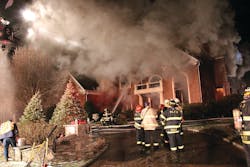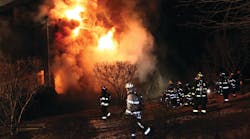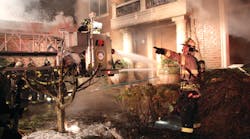This concludes a multi-part account of a close call experienced by the Manhasset-Lakeville Fire Department (M-LFD) of Long Island, NY, at a house fire on Jan. 18, 2014. Thanks to M-LFD Chief of Department Christopher Pisani and Deputy Chiefs Kirk Candan, Michael Farrone, Scott Garrigan and Mark Kiess for their assistance. Also, thanks to Lieutenant Sean Dolan, Firefighter John McCann, Lieutenant Lee Genser, EMT Tracey Dolan, Fire Commissioners Donald T. O’Brien, Andrew J. DeMartin and Brian J. Morris as well as all the members and mutual aid departments who responded to this incident.
This month’s column focuses on lessons learned and reinforced and on observations by responders. The comments by M-LFD officers and firefighters are in boldface, with Chief Goldfeder’s comments following in italics.
M-LFD – Basement fires are always tough. Conditions such as limited access, entering through the thermal layering, non-exposed fire conditions all prove to make these some of the toughest fires to fight. It is important for officers/acting officers to limit the number of members committed to the basement, especially in the initial stages of an operation. By limiting the members in the basement to the first-due engine at this fire, it made it easy to quickly exit the basement and the structure when the urgent message was transmitted.
Chief Goldfeder – Good coordination, lines being stretched and accountability by M-LFD allowed for every member to survive this fire. This fire is also a great lesson for all of us that basement fires can turn ugly quickly. When the occupants are accounted for, firefighting in “modern” lightweight wood truss dwellings such as this can or may have to be a “switch strategy” quickly. While the initial personnel went in to investigate, it got ugly quickly and evacuation must be the priority, especially when it is known that the occupants are out.
Having a member at the bottom of the stairs proved extremely helpful in this basement fire. This member was able to limit who came into the basement, as well as draw members who became disoriented back to the stairs to speed up the ability to get out of the basement. The large floor plan of the basement as well as the many obstacles within caused many members to become disoriented and turned around while trying to exit.
This “control” firefighter proved to be of value when the members were ordered out in coordinating accountability – and a means to get out. The use of a senior member ensured that the member would stay and do that job, versus a less-disciplined and perhaps less-senior member who may have freelanced. When staffing allows it, this position, be it filled by an officer or firefighter, can be of great value in helping coordinate operations and accountability.
Radio discipline is a must at any fire. When an Urgent is transmitted, all non-essential transmissions must cease. It is also important to ensure that your acknowledgement of the message was heard by the necessary people.
Remember the term “DIMWIT”: “Does It Matter What I’m Transmitting?” If not, stay off the radio. One moment of transmission could cover another member’s only chance for reporting a Mayday. On the other hand, when you see a problem or conditions changing, let command know.
The first-due engine picked up a bad hydrant. Information must be transmitted to the incident commander so a water source can be found or problem be fixed.
A dead hydrant or other problem with something command is expecting is a good time for a radio transmission!
Each engine should always find a hydrant. Don’t park an engine on the side of the road. Two lines maximum off of each engine (you don’t want to put all your eggs in one basket) in case an engine has a problem.
Great advice. Even when engine company staffing may be assigned to staging or to operate, an engine that is not on a hydrant is of no value.
Leave the front of the house open for the truck. Dwelling fires are mainly portable-ladder fires, but in this case we needed an aerial. You don’t want to have to start moving rigs around to get trucks in front of the house.
More and more, we are seeing less need for members to go to the roof of these kinds of fires, with the focus of getting water on the fire using the most direct and rapid way possible being the priority. However, for rescue purposes (members or occupants) or for master-stream potential, make sure the trucks have “reserved parking” available. Engines can stretch supply lines as well as handlines, but trucks cannot stretch their ladders.
As an incident commander, listen very carefully to all of the reports being given to you, especially from members with time and knowledge.
Consider the planned use of a command aide. Be it a senior firefighter, former chief or whatever works at your department, an experienced firefighter aide to the incident commander is of great value when managing multiple tasks on a working fireground. Also, make sure that “your” dispatcher can monitor the fireground. Firefighters’ lives have been saved by good dispatchers monitoring the fireground and hearing transmissions that were missed by command.
Fireground awareness – do your size up, do a walk-around, know your buildings, listen to the radio, know what’s going on.
The 360-degree size-up (walking around the building to see all sides) has proven to save firefighters lives. Failure to conduct a 360 has resulted in well-documented firefighter deaths.
Every member entering the IDLH (Immediately Dangerous to Life or Health) environment must be equipped with a portable radio).
In quoting Chief John Salka, it’s 2014, and there is no reason why every firefighter operating on the fireground should not have a portable radio. It’s a no-excuse statement, which doesn’t mean everyone has to talk, but if they have an emergency, how else will they let you and others know?
When an Urgent or Mayday is given, radio traffic must stop and everybody must listen to the radio.
While we spend time training for hands-on operations, hands-on use and radio protocols are equally important. What is your department’s Mayday procedure? What do the “non-Mayday” firefighters do when a Mayday is transmitted? When is the roll call conducted? How long do you give a company to answer before you declare a Mayday? What channel do the members operate on? What does your dispatcher do? Can your dispatcher even listen to your fireground? When they hear Mayday, what are their steps 1, 2, 3, 4, 5 and beyond (such as a full-alarm assignment to staging, special operations units, technical rescues, collapse units, water supply units, EMS, helicopters, etc.)? Plan now – you will not remember all that may be needed if you have to deal with a Mayday.
Know your buildings, whether you are a member of a career or volunteer department. We knew these buildings were lightweight because we conducted drills on them when they were being constructed in 1999.
A reminder for departments to “get out of the firehouse” and know what you will be responding to. Know your response area. Rarely should a department arrive on a scene and be surprised by what is encountered. The outcome can be disastrous. Most of us have pre-planned buildings and there is that great feeling that goes along with knowing what you are dealing with when you arrive and it’s on fire.
Buildings should be marked with some sort of truss identification; for example, stickers or markers on outside meters.
Many areas do this and it is a great extra tool to remind us of what we are dealing with. However, don’t count on stickers that can fade or be removed over time. Know the buildings.
If you have a dispatch pre-plan program, be sure it is updated and printed on run sheets, announced by dispatch when units respond and available on mobile data terminals.
With today’s computer-aided dispatch (CAD) systems, dispatchers can provide us with loads of valuable information. However, we have to take the time to get that information into the system. What’s your fire department’s plan? Pre-plan your area, as well as your response assignments. Know what is dispatched on what types of calls and why? How many companies will be needed if it is on fire? Plan that now, well before the fire is reported. At this fire, M-LFD’s first-alarm assignment (Companies 1, 2, 3 and 6 plus Company 4 as an add-on due to immediate staffing being available) matched the building they responded to in order to conduct the predictable tasks that must be performed.
At a basement fire, always have that second line stretched as a backup to protect members and means of egress. When dealing with lightweight wood construction, try to determine as quickly as possible whether you are dealing with a content fire or structure fire.
Basement fires are being looked at much closer these days, with several new suggested changes in tactics. Our department, along with our auto-mutual aid departments, recently turned out for a fire in a 5,000-square-foot house. Upon arrival, we had heavy, pushing smoke on sides B and C. Upon conducting a 360, our first-arriving captain identified heavy fire conditions in the basement with neighbors advising that all occupants were out. Upon further size-up, the first floor had collapsed. He ordered personnel to operate defensive and we flowed 700-plus gpm via three handlines into the basement from the direct-access windows. Companies opened up the C side and we coordinated opening the A side. The fire was stopped, members made entry from the A side and we saved a lot for this family.
In that fire, we used the relatively new fire behavior training we had received – to get water on the fire as quickly as possible while doing our best to not be in the flow path or on the floor above the fire, which in this case had collapsed. In the M-LFD fire, light smoke was showing initially, letting members make entry and find the fire, which had greatly advanced, but was not yet obvious. As they continued to open up, the “hidden” fire made itself known and took off at great acceleration.
Drill and train until you think you know it all. Then, at that point, drill and train even harder because in firefighting you never know it all. Things can change and are changing every day. We had a well-advanced fire on arrival that was working its way throughout the basement walls and ceiling. This was not a content fire, but rather a structure fire. As soon as we recognize that the structure in lightweight construction buildings is involved with fire, we must re-think our interior attack plan.
No matter what the fire department, we generally want to go in and attack the fire – and in many cases, that’s exactly what we need to do. But it always depends on your size-up, conditions and immediate resources available (people and equipment). M-LFD’s initial size-up and conditions let the companies conduct an interior search – for the fire. But as time quickly passed, conditions worsened, indicating a working structural fire (the building was burning, not just the contents), in which Chief Pisani then switched from an offensive fire to defensive. This, following rapid changes of conditions (heat and smoke) including Chief Candan identifying the floor shifting – and ordering all members out “urgent.” Had it not been for this observation, the outcome of the fire would have been significantly different.
Training all of our members in building construction and teaching them how to recognize the signs of lightweight construction are very important and will be added even more aggressively to our training schedule:
• Constant size-up and monitoring of changing conditions is imperative for everyone on the fire scene. I went from wearing no mask and walking into this building to crawling out wearing my mask in zero visibility.
• The thermal imager is an excellent tool, but it did not show any of the fire in the floor I assume was under us while we were searching. The double sheetrock, tile floors and carpet shielded most of the heat signature we would have noticed during the first scan with the thermal imager of the enclosed room we searched.
• The lightweight wood truss did what it was supposed to do – it failed. I just consider us lucky that the initial collapse, or floor sag, gave us a last chance to evacuate prior to any catastrophic collapse.
Basement fires have a well-documented history of killing firefighters. By nature of structural design, basement fires are killers. Modern fire behavior research shows that fire suppression (flowing water directly on the fire) should be conducted from a “non-basement” position such as through a doorway or window opening to lower temperatures in the fire area rather than the traditional means of advancing a hoseline interior to the seat of a fire. This new research suggests an increase in potential survival time for occupants (not applicable in this case, as all occupants were confirmed out) and workable conditions for the members. In this case, the M-LFD members had light smoke showing, justifying the initial search for fire. After all, there was no fire to attack at that point. However, as observed here, fire, heat and smoke from the basement quickly spread upward and throughout the building.
Basement fires are one of the toughest fires we operate on and as with all runs, a survivability profile must be part of the initial and ongoing size-up. If command decides it is necessary to enter the basement, an interior fire attack strategy with properly coordinated ventilation is necessary to ensure our survival. While not applicable for the residents at this fire, as they were outside upon the fire department’s arrival, history tells us that a working fire in a basement (on our arrival) usually provides little to no chance of survival of occupants in that area.
In many cases, a well-proven method of attacking a basement fire is from the same level, such as a walk-out doorway. As seen at this close call, the choice to operate above the fire places members at a higher risk of injury or death from the structural collapse. The structure should be evacuated immediately if structural compromise is determined, which was done by the M-LFD leadership.
Final comments by Chief Goldfeder about the response to this fire:
As stated by all of the contributors, this fire could have ended much worse. The M-LFD protects a community of some very old structures all the way up to the newest of the new, the lightest of the light and related buildings that kill firefighters. In this case, the lessons learned from the M-LFD include:
• Know the buildings you respond to, residential and commercial.
• Mask up and stretch multiple primary and backup lines immediately whenever any smoke is visible.
• Continually size-up (all ranks, from command to firefighter) and watch for changing conditions.
• Conduct a survivability profile. The occupants were out, so this was an attempt to save their home, which initially was appropriate, keeping in mind that little smoke was showing. Within minutes, though, as companies operated and opened up, the fire that had been burning for a while was found, spread and it took off quickly.
• This home may have been “lost,” but only a sprinkler system could have prevented that. On the other hand, due to the actions of the officers and members of M-LFD, this house can be rebuilt – and that’s the worst of it.
William Goldfeder presents “ ‘THAT’ Working Fire: Is It Predictable?” and “Another House Fire, But This One, We’ll Never Forget” at Firehouse Expo 2014.
Tactical Considerations at Fires In One- and Two-Family Homes
These are tactical considerations that firefighters should use to improve their understanding, survival and decision-making when sizing-up a fire in a one- or two-family home. These considerations are based on multiple tests and studies conducted by Underwriters Laboratories (UL) working with veteran fire service leadership as well as case studies involving fire collapse.
• Collapse times of all unprotected wood floor systems are within the operational time frame of the fire service regardless of response time.
• Size-up should include the location of the basement fire as well as the amount of ventilation. In tests, collapse always originated above the fire and the more ventilation available the faster the time to floor collapse.
• When possible, the floor should be inspected from below prior to operating on top of it. Signs of collapse vary by floor system; Dimensional lumber should be inspected for joist rupture or complete burn through, engineered I-joists should be inspected for web burn through and separation from subflooring, parallel chord trusses should be inspected for connection failure and metal C-joists should be inspected for deformation and subfloor connection failure.
• Sounding the floor for stability is not reliable and therefore should be combined with other tactics to increase safety.
• Thermal imagers may help indicate there is a basement fire, but cannot be used to assess structural integrity from above.
• Attacking a basement fire from a stairway places firefighters in a high-risk location due to being in the flow path of hot gases flowing up the stairs and working over the fire on a flooring system, which has the potential to collapse due to fire exposure.
• It has been thought that if a firefighter quickly descended the basement stairs, cooler temperatures would be found at the bottom of the stairs. The experiments in the studies and tests showed that temperatures at the bottom of the basement stairs were often higher than the temperatures at the top of the stairs.
• Coordinating ventilation is extremely important. Ventilating the basement can create a flow path up the stairs and out through the front door of the structure, almost doubling the speed of the hot gases and increasing temperatures of the gases to levels that could cause injury or death to a fully protected firefighter.
• Floor sag is a poor indicator of floor collapse, as it may be very difficult to determine the amount of deflection while moving through a structure.
• Gas temperatures in the room above the fire can be a poor indicator of both the fire conditions below and the structural integrity of the flooring system.
• Charged hoselines should be available when opening up void spaces to expose wood floor systems.
Source: UL Firefighter Safety









